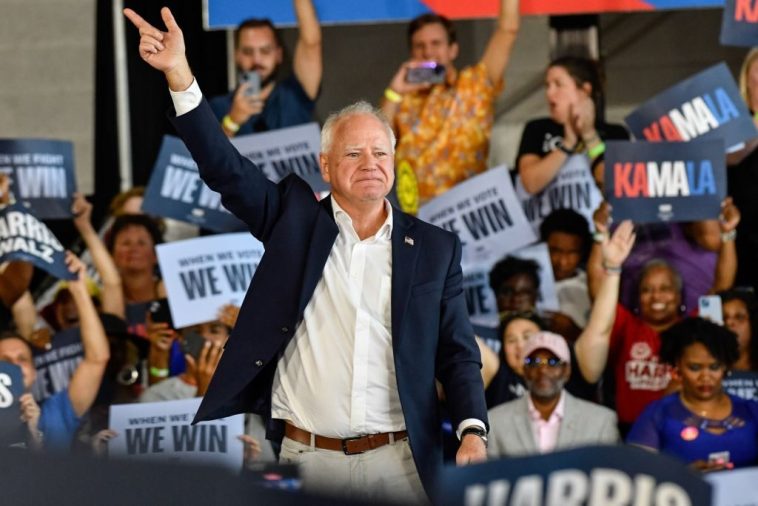Vice President Kamala Harris took a stance on a contentious topic, revealing her intent to reinstate the bipartisan border security bill if elected. This proposal was initially drafted by both Republican and Democrat officials, who seemingly shared a common interest in bolstering border control and pushing for stricter immigration procedures. The idea was to solve the immigration crisis by beefing up manpower resources, accelerating immigration verdicts, and restricting asylum claims in the U.S. However, the real question to consider is whether these measures would truly provide any effective solutions for the U.S. immigration crisis.
The National Border Patrol Council, a union representing Border Patrol agents, had endorsed the earlier draft of the proposal. That said, their backing fell through when former president Donald Trump intervened, pressurizing Republicans into withdrawing their support for the bill. It is notable that during Biden’s three-year tenure, an alarming average of 2 million individuals were arrested on an annual basis for attempting illegal border crossings. One has to wonder if the Harris proposal would bring any substantial change on this front.
A slight easing of the situation occurred over the summer, when the number of illegal border crossings dropped somewhat. This decrease was associated with the Biden administration’s imposition of limitations on asylum during periods of elevated illegal border crossings. Yet, despite this progress, immigration remains a contentious issue, viewed as a thorny problem during the 2024 elections.
Interestingly, pre-election polls indicated a potential vulnerability for Harris, with voters signaling their concern about her handling of immigration issues. Trump attempted to exacerbate this perception by assigning Harris the label of ‘border czar.’ This insult was aimed at attributing the nation’s immigration challenges to her, overstating her role as Vice President in solving the root issues that prompt migration from El Salvador, Guatemala, and Honduras.
Delving further into Harris’s proposed immigration plan shows a seeming lack of solid solutions. Her plan includes driving the recruitment of more Border Patrol agents as part of its long-term vision. A previous consensus between Republicans and Democrats in Congress saw an agreed plan for bolstering border security with an increased roster of immigration officers and judges. Yet, despite this apparent agreement between the two parties, the bill has been stalled. One must question whether Harris can indeed ensure the passage of this bill if she comes into power.
Another plank of Harris’s plan involves expanding immigration detention facilities, adding an additional 16,000 beds to the existing 34,000. There’s also a particular emphasis on increasing the staffing levels among officials tasked with determining immigrant stayers and leavers. It’s clear that these measures represent an intent to step up enforcement rather than genuinely solve the complex issue of immigration.
Further, the bill involves the recruitment of 4,300 new asylum officers in an attempt to expedite the process of determining those who qualify for asylum. Harris seems confident this approach would eliminate the latency in the system, speeding up the removal of those who fail to qualify. Yet, it’s fair to question whether this move might discourage potential asylum seekers instead of solving the very issues that compel them to leave their native countries.
As Vice President, Harris supported limitations on new asylum claims during spikes in illegal border crossings. This decision makes one question her commitment to providing a safe refuge for those fleeing persecution in their home countries. What does it say about her administration if its first instinct is to cordon off the border to asylum seekers in times of crisis, rather than extending support and compassion?
Harris has also supported stricter regulations in the border security deal, thus placing higher burdens on asylum seekers. The new conditions suggest asylum seekers must prove that no safe location exists for them in their home country to evade persecution, including the option of relocating within their country. However, such provisions are unrealistic in many cases and might discourage qualified asylum seekers from seeking help.
Harris, in her rally in Arizona, reinforced her perceived tough stance on border issues, yet at the same time attempted to craft a more compassionate approach toward immigrants. She insisted that America does not need to choose between securing the border and creating a more organized and human immigration system. But one must ask, how do these seemingly contrasting views align in practice?
As part of her broader immigration outlook, Harris is pushing for the addition of 250,000 family and employment-based visas over five years. The former Vice President has stated these provisions were included in the bipartisan border securities deal she intends to resuscitate. Yet, this seems less about the welfare of immigrants and more about supporting economic interests within the United States.
Beyond these measures, Harris has expressed her intention to carve out a pathway for unauthorized residents in the U.S. to obtain citizenship. While this promise might lead some to perceive Harris as a progressive leader, one must seriously question whether she has the resolve needed to push such a transformative initiative through Congress.
In a final thought, Harris stated in Arizona, ‘I will work with Congress to create, at long last, a pathway to citizenship for hardworking immigrants who have been here for years, for years, and deserve to have a system that works.’ These lofty promises notwithstanding, the question remains whether the reality will match the rhetoric. Only time will tell whether her proposals, if implemented, can genuinely resolve the U.S. immigration crisis or whether they will merely perpetuate it under a new guise.


